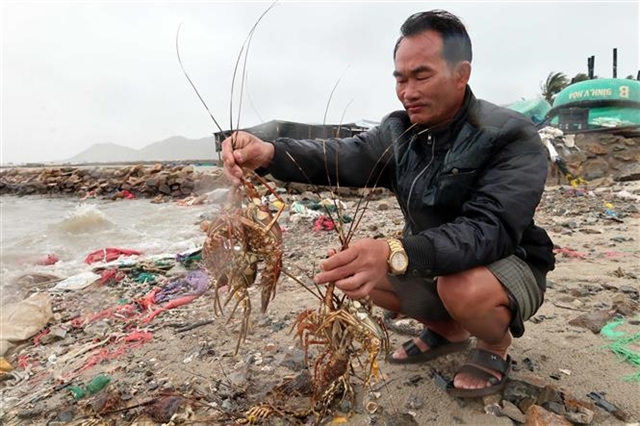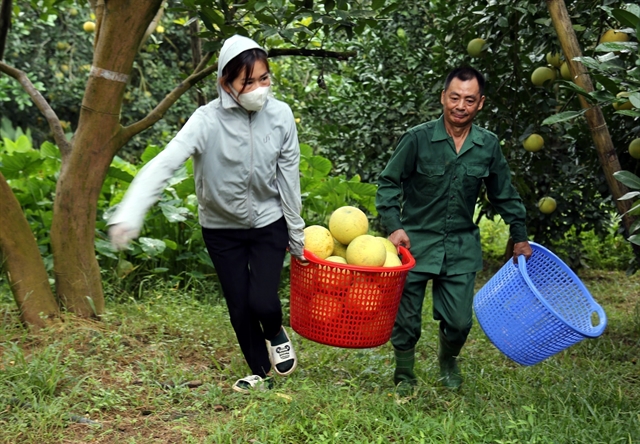 Society
Society


|
| Farmers in Soi Hà Village, Xuân Vân Commune harvest pomelo. — VNA/VNS Photo Quang Cường |
TUYÊN QUANG — Soi Hà pomelos have been receiving more and more positive feedback from consumers thanks to their good taste and look, turning a tidy profit for farmers in the northern province of Tuyên Quang.
Đỗ Khắc Thỏa is a farmer in Soi Hà Village, Xuân Vân Commune, Yên Sơn District. He was one of the first to plant pomelo in the village.
About 40 years ago, his family left their hometown in the northern province of Hà Tây (now part of Hà Nội) to relocate to the northern mountainous province of Tuyên Quang, taking some small pomelo trees with them.
At that time, people in the mountainous commune mainly grew corn, cassava and sugarcane as their main crops, Thỏa said.
"My pomelo trees adapted and grew well with the soil and weather here," Thỏa said, adding that pomelo farming has helped expand the commune.
In the last two years, Thỏa applied VietGAP standards on his 2ha pomelo farm.
"I see an increase in both quality and productivity of the pomelo," Thỏa said.
Before being sold in the market, all Thỏa's pomelos are stamped with an origin traceability code which helps him earn consumers' trust.
He added that the consumption of pomelo now was very convenient.
At the beginning of the season, traders come to pay a deposit to buy the whole garden, even if the pomelos are small.
Thỏa mainly sells pomelo to wholesalers. Currently, Soi Hà pomelos have a price ranging from VNĐ20,000-30,000 per fruit.
With two hectares of sweet pomelo being harvested, minus all expenses, Thỏa's family earn more than VNĐ400 million per season.
In 2017, Soi Hà pomelo was voted by the Vietnam Consumers Association as one of the top ten famous brands. In 2021, the Ministry of Science and Technology granted a geographical indication certificate for Soi Hà pomelos grown in the Yên Sơn District. This is the third product of Tuyên Quang Province to be granted a geographical indication certificate after orange grown in Hàm Yên District and Shan Tuyết tea grown in Na Hang District.
Lê Hồng Việt, chairman of the People's Committee of Xuân Vân Commune, Yên Sơn District, said that in the commune, there were nearly 900 hectares of pomelos, of that, more than 200 hectares were for Soi Hà pomelo varieties.
"In the future, the commune People's Committee continues to coordinate with agencies and departments of Yên Sơn District to encourage people to focus on improving the quality of the existing pomelo area, not massively expanding the pomelo growing area," he said.
"Local authority advice pomelo farmers to associate with cooperatives and businesses, put pomelo products into supermarkets to improve the value and increase income for pomelo growers," Việt said.
According to the district's Department of Agriculture and Rural Development, pomelo trees have been planted widely since 2002.
From a few dozen hectares, up to now, the total pomelo growing area in the whole district has reached over 4,000 hectares. Although the market for consuming pomelo is currently relatively sound, the economic value brought by pomelo farming is still leading in the crop structure in the district.
There has not been a situation of oversupply.
"We have developed a plan to put pomelo products on the electronic trading floor. However, when pomelo products are put on the electronic floor, the producer must be more flexible in adjusting the design and quality to meet consumers' demand," said Tạ Văn Tình, head of Yên Sơn District's Agriculture and Rural Development Department.
To improve the value of pomelo trees, the district People's Committee opened scientific and technical training conferences and transferred new science and technology applications for farmers. The district also eyes potential to export pomelo products. — VNS




.jpg)